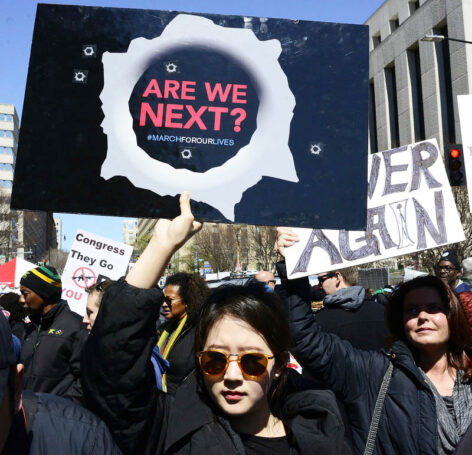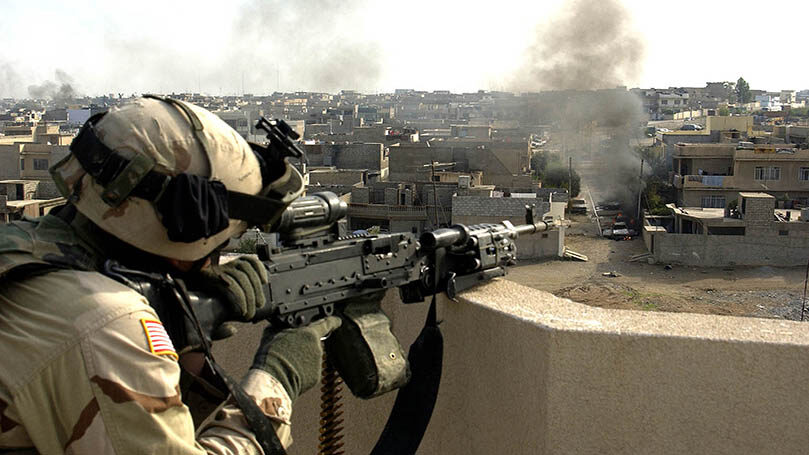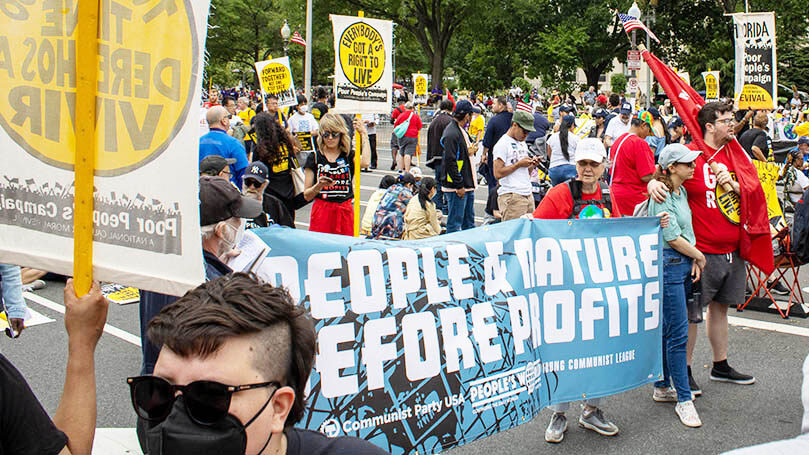
When I read about the June 18 Poor People’s Campaign Moral March on Washington, I came across this statement by Bishop William Barber, the campaign’s national co-chair:
Republicans say poverty is just a personal failure. And Democrats too often talk about the working class and those trying to make it into the middle class but refuse to speak expressly on poverty. Our debates are locked in struggles around and about trickle-down concepts of neoliberalism and middle-class considerations.
He concluded that the country’s refusal to address poverty is “the basic moral contradiction” of our time.
I have to admit that I initially bristled at the idea of a “moral contradiction” because, as a non-religious person, that language sometimes raises red flags for me. But I began to think about how Marxists discuss the concept of contradiction.
What is a contradiction? All social phenomena contain contradictions. Contradictions aren’t simply accidents but essential features of what those objects are.
For example, the U.S. is a society that describes itself as free and touts its wealth but is plagued by the poison of white supremacy and male supremacy. It has 142 million people living in dire poverty or one paycheck, one health crisis, or one disaster away from financial desperation. More than 52 million workers earn less than $15 per hour and often can’t meet their basic needs.
 We brag about advanced technology, such as medical technology and knowledge. Still, we couldn’t prevent the loss of 1 million lives from COVID or 100,000 opioid overdose deaths, or 46,000 deaths from guns. We wring our hands while nothing gets done. We wonder why we never see these things coming or are constantly reacting only after so many people have been harmed.
We brag about advanced technology, such as medical technology and knowledge. Still, we couldn’t prevent the loss of 1 million lives from COVID or 100,000 opioid overdose deaths, or 46,000 deaths from guns. We wring our hands while nothing gets done. We wonder why we never see these things coming or are constantly reacting only after so many people have been harmed.
We boast about an advanced educational system but cannot provide it free or at a reasonable cost to the mass of working-class people. Decades-long debt peonage is the best choice we have. Politicians cut school and university budgets as illiteracy grows, and workers score poorly on tests that measure competence with mathematics and language.
These are essential contradictions that define the U.S. as a social formation. They aren’t just bad choices made by an otherwise just society.
This reality shapes how I read Barber’s comments. “Moral contradiction” causes one of the major political parties to demand that the state control women’s bodies by banning safe abortions, claiming the human rights of unborn fetuses. But then, the next day, it votes as a bloc against immediate steps to remedy a baby formula shortage. A baby formula shortage!
Yes, the right-wing built a morally bankrupt political platform. But the moral contradictions of the capitalist market economy, which they cherish even above life itself, are central pillars of the whole system. Abortion and baby formula are just the most recent plain examples.
Contradictions
Why do we care about contradictions like this?
Social systems change and develop based on how social and class forces address these contradictions and turn a system into a new substance.
Many capitalists and their sympathizers see contradictions as mere inconsistencies or glitches. Reformers want to fix these glitches and bring our “values” back into alignment with our actions. Or, they want to mend these problems by creating philanthropic or socially innovative programs that help out the poor but leave the system intact.
Billionaires and fascists have different ideas about resolving contradictions. Think of Elon Musk’s recent embrace of the Republican Party and its fascist platform. He is mad that the government continues to investigate his suspicious financial activities and is afraid unions will weaken his absolute power in his companies. He wants state power that he can personally bend to his will to help him get over his emotional problems. He wants more power to resolve contradictions through coercion and legal force.

Imperialism uses war to resolve contradictions. Consider the U.S. government’s drive for war in Ukraine. It manufactures images of Russian human rights abuses—some of which are undoubtedly true. But the U.S. record of torture, mass killings, destroying civilians, mass incarcerations, assassinations, political interventions, and hybrid wars on a global scale, in just the past two decades, embarrass even people like Henry Kissinger, among the vilest of abusers. George W. Bush’s recent verbal slip about punishing the warmongers who started the Iraq war wasn’t just a gaffe.
Though immoral, these aren’t simply moral inconsistencies. They are contradictions that comprise the structure of U.S. capitalism and its political system. Its capitalist class, on the whole, believes it must maintain these structural forms of power if the U.S. is to keep its hegemonic position in the imperialist world system. In simple terms, these contradictions make the U.S. what it is as a country. This structure drives us from war crisis to economic crisis to health crisis and back all the way around again. So far, our only means of psychological survival has been self-induced amnesia. Forgetting, like self-medication, eases the pain of this moral contradiction, which I believe most of us deeply feel.
Barber’s terminology about moral contradiction is essential. And amnesia is no longer a practical solution. However, working-class power transformed into social power could be the basis for an answer.
Imperialist world system
In the present world system, five fundamental contradictions are interconnected and reveal moral bankruptcy, logical inconsistencies, and anti-human tendencies that make capitalism what it is:
- A world imperialist system that denies most humans their national aspirations
- Worldwide poverty that denies human dignity on a scale of billions
- Deepening rates of exploitation that spark frequent crises of overproduction
- Global socialization of labor vs. the anarchy of national systems that rely on the capitalist market economy
- Excess capitalist production without rational planning for the survival of humanity and the planet
What is a world system? “World system” is not a conspiratorial term, nor does it refer to “globalism” or the “deep state” or any mystifying right-wing concepts about evil hordes of racial others dominating the U.S. or Europe. Those racist and anti-Semitic theories drive right-wing capitalist agendas and fascist violence.
 The world system names the dominant form of global integration of countries into the capitalist-imperialist system in a particular period. For example, European slave-trade–based capitalist development, led by Spain and Portugal in the 15th and 16th centuries, the Dutch in the 17th century, and Great Britain in the 18th and 19th centuries, formed a world system based on markets in human beings as a financial basis for market and industrial capitalist development. It created a settler-colonial-slavery complex, driving Indigenous genocide in the Americas. It made modern capitalism possible. (Gerald Horne’s The Dawning of the Apocalypse, The Apocalypse of Settler Colonialism, The Counterrevolution of 1776, Negro Comrades of the Crown, and Confronting Black Jacobins can be read sequentially as a study of this world system. Joseph Inikori’s Africans and the Industrial Revolution in England is also an informative study of one aspect of that system.)
The world system names the dominant form of global integration of countries into the capitalist-imperialist system in a particular period. For example, European slave-trade–based capitalist development, led by Spain and Portugal in the 15th and 16th centuries, the Dutch in the 17th century, and Great Britain in the 18th and 19th centuries, formed a world system based on markets in human beings as a financial basis for market and industrial capitalist development. It created a settler-colonial-slavery complex, driving Indigenous genocide in the Americas. It made modern capitalism possible. (Gerald Horne’s The Dawning of the Apocalypse, The Apocalypse of Settler Colonialism, The Counterrevolution of 1776, Negro Comrades of the Crown, and Confronting Black Jacobins can be read sequentially as a study of this world system. Joseph Inikori’s Africans and the Industrial Revolution in England is also an informative study of one aspect of that system.)
These kinds of global interactions gave capitalism a racial characteristic it still relies on to maintain its capacity to accumulate surplus value and recirculate it as new capital.
By the end of the 19th century, this slavery-settler system transitioned to an imperialist-colonial system. It kept critical features of the former, as settler features persisted in southern Africa until 1994. And Canada, the U.S., and Australia continue to deny land and sovereignty to the Indigenous people who hold rightful claims. European powers, sometimes with agreement among themselves but always in fierce long-term competition, strove to conquer and dominate the entire earth.
That system collapsed during the Great Depression and subsequent global war. Fascism — the most extreme form of capitalism and imperialism—pitted Europeans against one another in unprecedented ways. Within two decades, the colonialism system followed suit.
After this unprecedented world system collapse, the U.S. managed to rise to the top of the heap. The debts incurred by the imperialist powers and the U.S.’s skillful management of the shift to dollarized neo-colonial control of former European colonies enabled this transition. (W. Alphaeus Hunton’s Decision in Africa and Walter Rodney’s How Europe Underdeveloped Africa are essential for this history of U.S./European colonialism and neo-colonialism in African countries.)
Essentially, the U.S. drove a world system that expropriated vast tons of raw resources from the colonized world to fuel its own and Europe’s redevelopment after World War II. The collapse of the colonial regimes through national liberation struggles aided by the socialist countries prompted a transition to the domination of finance capital in the neoliberal regime of structural adjustments, privatization, forced labor, and hybrid war.
That new regime successfully produced wealth and power for U.S. capitalists, which one commentator characterized as the “end of history.” Meanwhile, vast billions of the human population suffered from extreme poverty, hunger, lack of health resources, rapid environmental change, disease, war, and conflict.

The end of “the end of history” came after a series of financialization crises ranging from the savings and loan crisis of the late 1980s and early 1990s to the dot.com bubbles leading up to the 2007 housing collapse, which ruined the bliss of everlasting capitalist success. The failure to conquer Iraq and Afghanistan, which sucked trillions out of the U.S. economy, further signaled U.S. decline.
Unlike the 1930s, when the U.S. political system responded to manage the contradictions through “Keynesian” economic theory and New Deal social democracy, the present system blunders along with handouts to the banks, tax cuts for billionaires, and more austerity. Today, we are at the end of 60 years of declining rates of growth that pale in comparison to China’s 8%–9% growth rates each year for the past 40 years.
The U.S. political class frequently admits that it can’t afford the hundreds of billions pumped into military spending and a universal health system each year. It can’t afford to buy new missile systems and quality schools and universities. It can’t provide a meaningful safety net and ensure record profits and wealth accumulation for millionaires and billionaires with low tax rates.
Even as globalization generates the socialization of labor on a world scale, the anarchy of capitalist market economies within national frames produced new internal contradictions in those ruling-class agendas. (I am indebted to Cheng Enfu’s China’s Economic Dialectic for the phrasing of this contradiction.)
This contradiction between the needs of the empire and the interests of national economic and political systems is evident in the conflict over Ukraine. Consider how deeply and violently the U.S. ruling class split over the Russia-Europe contest. Trump was willing to dump Europe for an alignment with Russia, while much of the U.S. capitalist class maintains corporate ties to Western Europe. We have yet to understand how much this conflict has altered and shaped U.S. domestic politics. (And the impending internal conflict over ties to China has only been kicked down the road.)
Over here
The U.S. capitalist class aspires to maintain its dominance of the imperialist world system. But this means they must carefully manage an increasingly expensive military, intelligence apparatus, local police, and border patrol system. The institutions operate strictly for global and domestic repression of dissent. These are the only spending priorities for which a nearly unanimous Washington consensus exists.
At the same time, capitalists discovered that their goal of endless higher profits had been little more than accounting schemes and fantasy for some decades. Corporate policies drove record profits with higher prices, lower wages, and benefit cuts, all aided by a significantly weakened labor movement since the 1980s. Further, accounting tricks like stock buy-backs and debt schemes made bubbles and fantasy wealth a mainstay of Wall Street chicanery.
The capitalist class’s drive to manage the top spot in the imperialist system propels deepening exploitation worldwide, and in the U.S. Initially, globalization of production made the low prices of imported goods seem like a boon. But then, the loss of manufacturing jobs meant a weakened labor movement, lower pay, and more frequent cycles of simply being unable to buy things. In some communities, whole neighborhoods became ghost towns. City services vanished overnight. Workers found they needed more than one job to survive. Consumption levels dropped, producing new levels of poverty combined with new demands for higher exploitation rates.

Racist mass incarceration became a mechanism for resolving some aspects of that crisis simply by cultivating and exploiting racism to punish Black, Latinx, Indigenous, and immigrant people with imprisonment, criminalization, and mass deportation. Euro-American racial solidarity seemed to be an appropriate alternative to multi-racial working-class solidarity.
Today, the performance of racial reforms (that aren’t reforms) and openly fascistic racist doctrine (great replacement dogmas, ravings about critical race theory, book burnings, and xenophobia) stand in for actual resolutions to deepening exploitation. Philanthropy and the non-profit industrial complex take the place of systemic solutions to poverty.
The anti-war movements (2002–2008), Occupy Wall Street (2011), #BlackLivesMatter (2014–2020), and worker uprising (2020–2022) have lain bare the crisis of the political system. They have uplifted specific analyses of different aspects of these five main contradictions.
Imperialist double jeopardy
Withdrawal from Iraq and Afghanistan signaled the severe jeopardy of U.S. dominance of the imperialist world system. In contrast to the past, it appears unable to assert its agenda for Eastern Europe, Central Asia, the South Pacific, or even Latin America, which it had long proclaimed its “backyard.” De-dollarization combined with new military blocs appear to be steps toward sovereignty for some countries.
Will this produce a new, competing imperialist system? Will this new situation solidify into two new geopolitical and economic blocs? Are we simply witnessing a deadly realignment of imperialist forces? Yes, each is possible—unless we bring internationalist, working-class revolutionary solutions.
The U.S. intervention in Eastern Europe, specifically in Ukraine, from 2014 to the present, has centered on promoting a proxy military conflict with Russia. State Department officials recently admitted to this. However, like its invasions of Iraq and Afghanistan, the results have been mixed for U.S. imperialism. It feels compelled to continue with this dangerous and deadly strategy, unfortunately.
While the most violent part of that conflict is still in its early stages, many ruling-class commentators may already be crying “uncle.” The New York Times recently opined that a negotiated settlement that concedes territory inhabited by Russian-language speakers to Russia might be necessary. Further, to provide promised energy resources to European allies, the U.S. was compelled to walk back its de-humanizing sanctions regime against Cuba and Venezuela.

On the gain side, the U.S.-Europe faction has drawn more “neutral” Sweden and Finland into its orbit and extracted billions in new contracts for U.S.-based weapons makers from Germany, the U.K., and other countries. But even these gains are fraught with localized contradictions, as NATO isn’t an ideologically unified bloc, and its actors hold competing and contradictory interests.
On the loss side, Russia controls vast amounts of natural gas and petroleum desperately needed in Eastern Europe. Their military power has proven to be far more robust than expected. Their restraint in this war (relative to U.S. “shock and awe” and Abu Ghraib/Guantanamo Bay–level atrocities) has proven disappointing to Western human rights watchers who regularly side with U.S. government interests.
The petroleum element of this war produces an internal domestic problem for the U.S. government. Rationed resources have driven up prices, even as oil companies look to deepen their already sizeable profits on gas-guzzling U.S. consumers. High prices are another form of deepening exploitation of workers and provoke political instability. The fascists are already exploiting this instability.
Meanwhile, the Western media and political establishments have soft-pedaled fascist movements that the U.S. has funded and used to spark international conflicts along the Ukraine-Russia border since 2014. Taking a page out of the Cold War playbook, the U.S. government has supported extremists, painting them as “freedom fighters.” Those choices have never ended well for U.S. imperialism, even if they allow imperialists to accomplish short-term goals. Think of the various U.S.-funded drug cartels in Central America (like Noriega’s in Panama), the mujahideen in Central Asia, the “contras” in Nicaragua, and the militarists in Chile, Indonesia, and South Korea.
End of humanity?
While the imperialist world system leaders plotted a Ukraine-Russia war, cried crocodile tears about “blonde, blue-eyed” refugees, and pumped billions of dollars into Ukraine to keep the war going, a United Nations call for immediate, urgent global attention to human-caused climate change went almost unheeded.
UN Secretary-General António Guterres stated in April 2022 that if the world continues on its present course, humans can expect new levels of suffering due to “unprecedented heatwaves, terrifying storms, widespread water shortages, and the extinction of a million species of plants and animals.” He referred to a report by the Intergovernmental Panel on Climate Change that showed a need for swift and immediate action within the next couple of years to turn back the climate’s worst effects.

Few within the U.S. political class seem concerned, let alone capable of leveraging the emissions reductions needed to protect human life. Indeed, maintaining world system dominance appears to be their only operating concern.
What do we do with these contradictions? They show us that imperialism cannot cure itself. Imperialism cannot deliver human rights and dignity to the people it regularly exploits and oppresses. Capitalism cannot end racism or stop mass killers motivated by racist theories. It cannot suspend its need for racist super-exploitation or its exploitation and destruction of natural resources, like the air we breathe, water, and soil in which we plant crops.
We have no time to celebrate the failure of capitalism to solve the problems it has created.
The working class, especially its socialist and communist parties, can fight for bigger organizations, clearer analysis, and class leadership. The socialization of labor on a global scale creates unprecedented levels of working-class power. It is the one lever with which we can move the immovable force of ruling class power and resolve the central contradictions of the present to change this world into something new. When working-class power becomes the supreme power in the world system, we have the means to win peace, avoid climate disaster, reduce exploitation, uplift the national aspirations of the world’s peoples, and bring our values into line with our actions.
Images: NATO Madrid Summit 2022, NATO (website); March for Our Lives, Stephen Melkisethian (CC BY-NC-ND 2.0); U.S. soldier in Iraq, Wikimedia (public domain); Cartoon, King Leopold II of Belgium, Snake of the Congo, by Edward Linley Sambourne, in Punch 1906, posted by Mike Licht (CC BY 2.0); Deforestation, World Bank Photo Collection (CC BY-NC-ND 2.0); Abandoned storefront, sj carey (CC BY-SA 2.0); NATO Summit 2022, NATO (Facebook); People & Nature before Profits, Erik Shilling.


 Join Now
Join Now